When deciding between screen printing and direct-to-garment (DTG) printing, it’s essential to consider your specific needs regarding quantity and design complexity. Screen printing is a cost-effective choice for larger orders, delivering vibrant colors and efficiency, while DTG excels in producing detailed designs for smaller runs. Understanding these differences will help you make an informed decision for your printing project.

Which printing method is more cost-effective for small businesses?
Screen printing is generally more cost-effective for bulk orders, while direct-to-garment (DTG) printing is ideal for smaller runs. The choice between these methods depends on the quantity of items needed and the specific design requirements.
Screen printing is cheaper for bulk orders
Screen printing becomes more economical as the order size increases. This method involves creating a stencil for each color, which can be time-consuming initially, but the cost per unit decreases significantly with larger quantities. For example, printing hundreds of shirts can bring the cost down to just a few dollars each.
Businesses should consider the setup costs associated with screen printing, which can include screens and inks. However, once these initial costs are spread over a large number of items, the savings become apparent. Typically, screen printing is most cost-effective for orders of 20 shirts or more.
Direct-to-garment is better for small runs
Direct-to-garment printing is more suitable for small runs, often allowing for designs that include multiple colors without the need for separate screens. This method is akin to using an inkjet printer, making it ideal for custom or one-off designs. For orders of 1 to 10 items, DTG can be more affordable and faster.
While the cost per unit for DTG is higher than screen printing for bulk orders, it eliminates the setup fees associated with screens. This makes it a practical choice for small businesses looking to offer personalized items or limited edition runs without significant upfront investment.
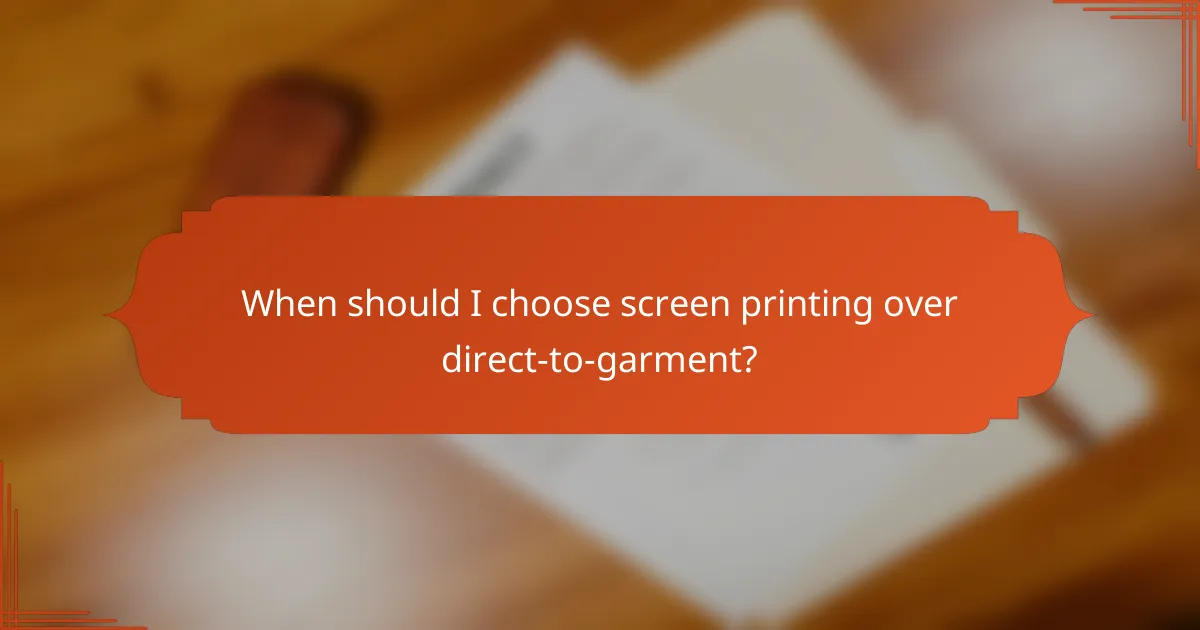
When should I choose screen printing over direct-to-garment?
Choose screen printing when you need to produce larger quantities of items efficiently and cost-effectively. This method is ideal for bulk orders, as it offers lower per-unit costs compared to direct-to-garment printing.
Use screen printing for larger quantities
Screen printing is best suited for orders of at least 20 to 50 items, as the setup costs are offset by the lower price per piece when producing in bulk. The process involves creating a stencil for each color, which can be time-consuming initially but becomes economical with larger runs.
For example, if you are ordering custom t-shirts for an event or a promotional campaign, screen printing can significantly reduce costs as the quantity increases. However, if you only need a few shirts, the initial setup may not justify the expense.
Choose direct-to-garment for complex designs
Direct-to-garment (DTG) printing is ideal for intricate designs that require a wide range of colors and detailed graphics. Unlike screen printing, DTG allows for high-resolution prints directly onto the fabric, making it suitable for designs with gradients or photographic elements.
This method is particularly advantageous for small orders or one-off items, as there are no setup fees involved. If you need a unique design for a single shirt or a small batch, DTG is often the better choice, despite the higher cost per unit.
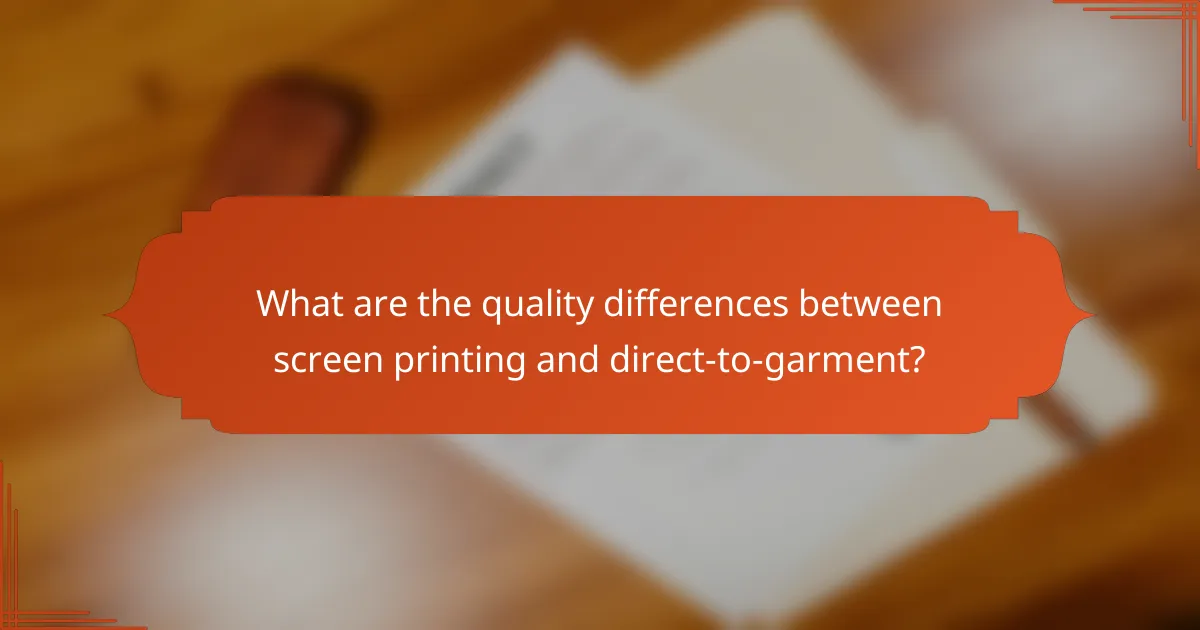
What are the quality differences between screen printing and direct-to-garment?
Screen printing and direct-to-garment (DTG) printing differ significantly in quality, primarily in color vibrancy and detail. Screen printing excels in producing bright, bold colors, while DTG is better suited for intricate designs and detailed images.
Screen printing offers vibrant colors
Screen printing is known for its ability to produce rich, vibrant colors that stand out on fabric. This method uses thick layers of ink, which results in a more saturated appearance compared to other printing techniques.
It is particularly effective for designs that require solid colors and bold graphics. For example, logos and simple illustrations often look best when screen printed, especially on dark fabrics where the contrast is enhanced.
Direct-to-garment provides detailed prints
Direct-to-garment printing excels in reproducing detailed images and complex designs. This method uses inkjet technology to apply ink directly onto the fabric, allowing for a wide range of colors and gradients.
DTG is ideal for designs that include photographs or intricate artwork, as it can capture fine details that screen printing may not achieve. However, it’s important to note that DTG prints may not be as vibrant on darker fabrics unless a white base layer is used.
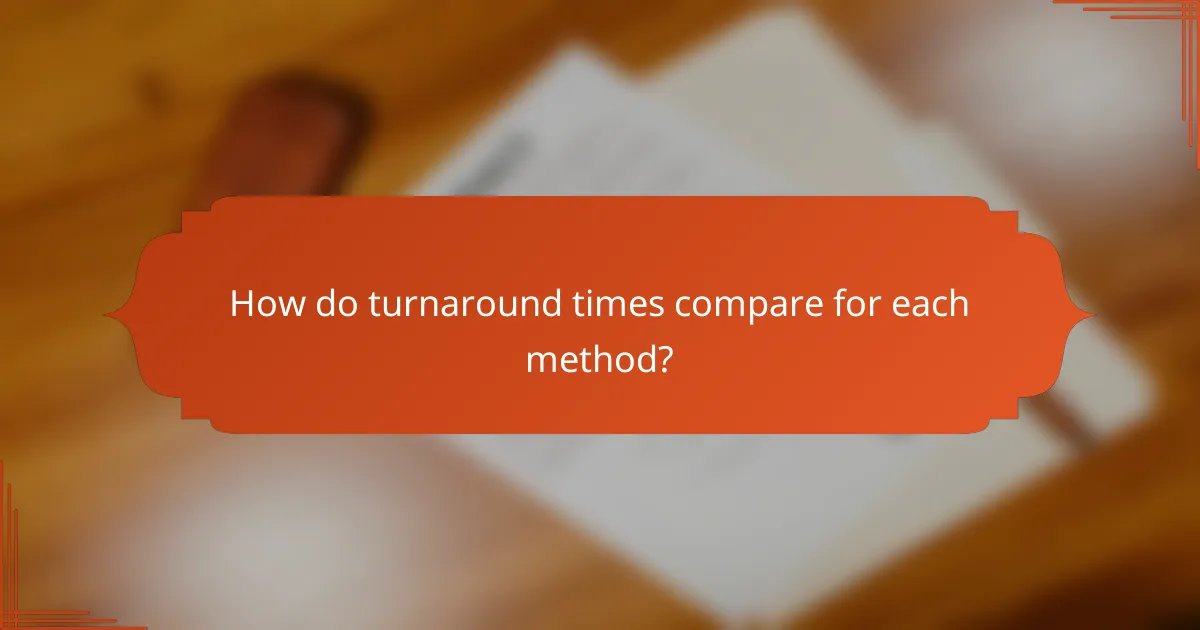
How do turnaround times compare for each method?
Turnaround times for screen printing and direct-to-garment (DTG) printing differ significantly. Screen printing typically requires longer setup times, while DTG allows for quicker production, making it more suitable for smaller orders or designs with many colors.
Screen printing has longer setup times
Screen printing involves preparing screens for each color in the design, which can take considerable time, especially for complex graphics. The setup process may require several hours, depending on the number of colors and the intricacy of the design.
Additionally, once the screens are prepared, the actual printing process can be efficient for large batches. However, the initial time investment makes screen printing less ideal for small orders or quick turnarounds.
Direct-to-garment allows for quicker production
Direct-to-garment printing eliminates the need for screens, allowing designs to be printed directly onto the fabric. This method can produce finished garments in a matter of minutes, making it highly efficient for small runs or one-off designs.
DTG is particularly advantageous for custom orders or when a variety of designs are needed quickly. However, it may not be as cost-effective for large quantities compared to screen printing, where the setup time is amortized over a larger number of items.
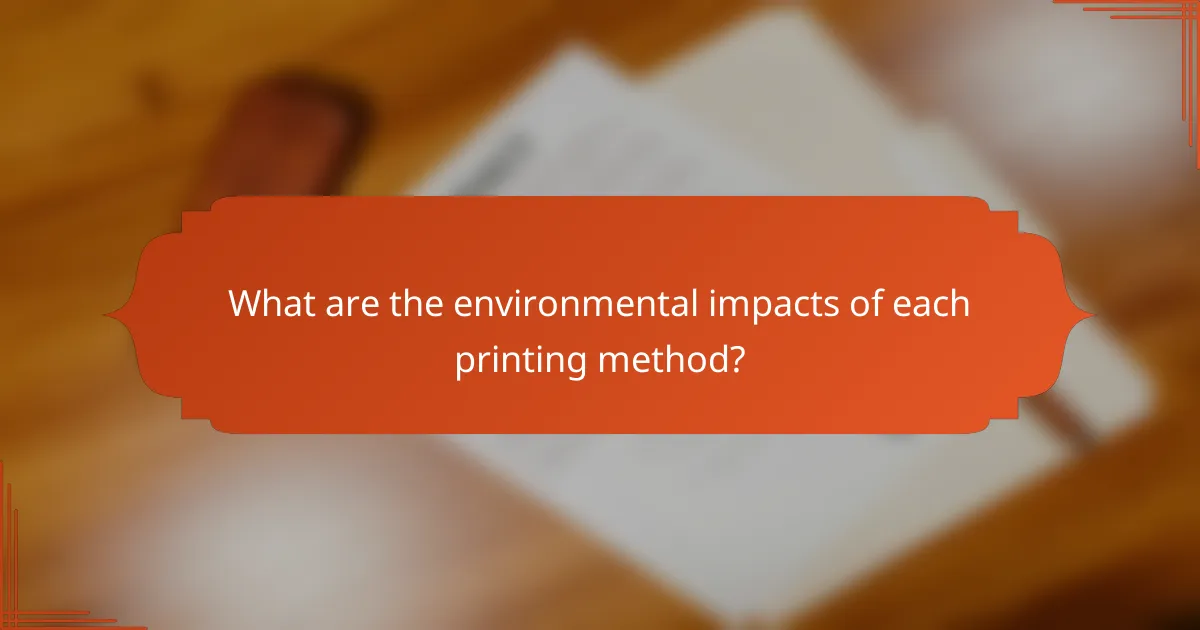
What are the environmental impacts of each printing method?
Screen printing and direct-to-garment (DTG) printing have distinct environmental impacts. Screen printing typically consumes more resources and generates more waste, while DTG is generally considered more eco-friendly due to its lower resource usage and waste production.
Screen printing uses more resources
Screen printing requires multiple screens for different colors, which can lead to increased material usage. The process often involves significant amounts of ink and chemicals, contributing to higher waste levels. Additionally, the energy consumption during setup and production can be considerable, especially for larger runs.
Due to the setup process, screen printing is more efficient for bulk orders, but this efficiency comes at the cost of resource intensity. For smaller orders, the environmental impact per item can be significantly higher compared to DTG.
Direct-to-garment is more eco-friendly
Direct-to-garment printing is more eco-friendly because it uses a digital process that applies ink directly onto the fabric, minimizing waste. This method typically requires less ink and fewer chemicals, leading to a smaller environmental footprint. Additionally, DTG allows for on-demand printing, which reduces overproduction and waste.
DTG printing is particularly advantageous for small runs or custom designs, as it eliminates the need for multiple screens and extensive setup. This flexibility not only conserves resources but also aligns with sustainable practices by reducing excess inventory and material waste.

What are the best applications for screen printing?
Screen printing is ideal for producing high-quality designs on a variety of materials, particularly when large quantities are needed. It excels in applications where durability and vibrant colors are essential, making it a popular choice for many businesses.
Ideal for promotional merchandise
Screen printing is particularly effective for promotional merchandise such as tote bags, water bottles, and banners. The technique allows for bold, eye-catching designs that can withstand the rigors of outdoor use, making it perfect for events and marketing campaigns.
When creating promotional items, consider the volume you need. Screen printing becomes more cost-effective as the quantity increases, often becoming the preferred method for orders in the hundreds or thousands.
Perfect for custom apparel in bulk
For custom apparel, screen printing is the go-to method when producing large batches of t-shirts, hoodies, or uniforms. The process allows for consistent quality across all items, ensuring that colors and designs match perfectly.
When planning a bulk order, keep in mind that screen printing works best with simple designs featuring fewer colors. This not only reduces costs but also speeds up production time, making it ideal for businesses needing quick turnaround on apparel orders.

What are the best applications for direct-to-garment printing?
Direct-to-garment (DTG) printing excels in applications where detailed designs and personalization are crucial. It is particularly effective for small to medium runs, allowing for vibrant colors and intricate patterns on fabric.
Great for personalized gifts
DTG printing is ideal for creating personalized gifts, such as custom t-shirts, hoodies, and tote bags. This method allows for individual names, dates, or unique messages to be printed directly onto the garment, making each item special.
When considering personalized gifts, keep in mind that DTG works best on cotton or cotton-blend fabrics. This ensures that the print adheres well and maintains its quality after washing.
Suitable for intricate designs on demand
DTG printing is well-suited for intricate designs that require high detail and color variation. This method can reproduce complex graphics, photographs, and artwork with precision, making it a favorite for artists and designers.
For on-demand printing, DTG eliminates the need for screens or setups, allowing for quick turnaround times. This is particularly beneficial for small businesses or individuals looking to produce limited runs without high upfront costs.
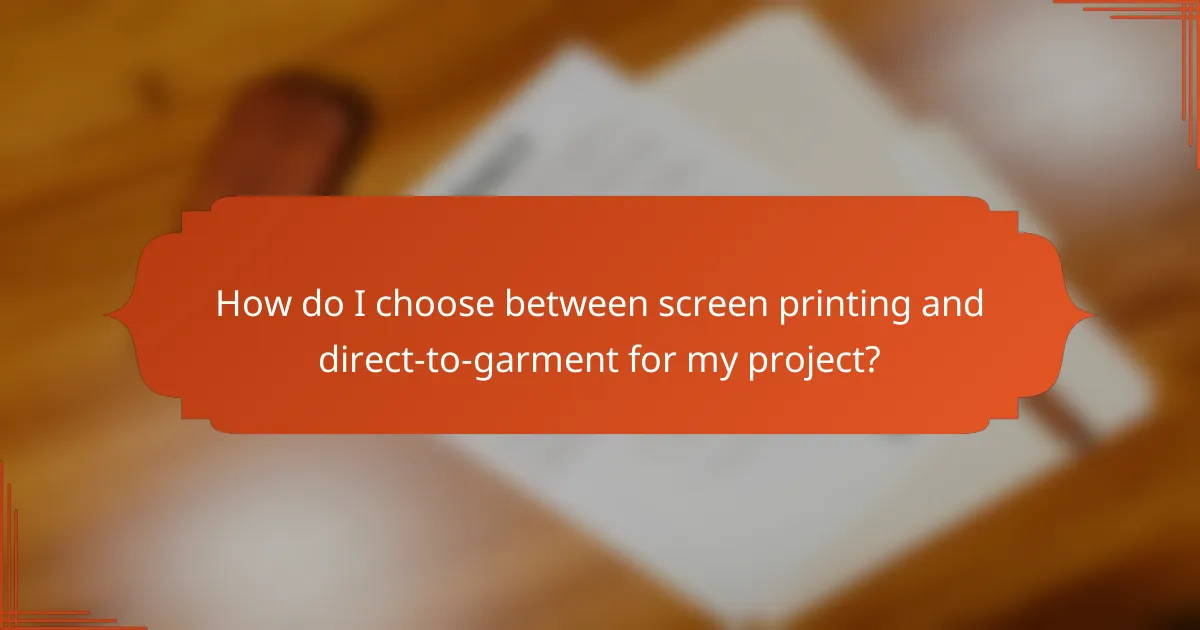
How do I choose between screen printing and direct-to-garment for my project?
Choosing between screen printing and direct-to-garment (DTG) depends on factors like order size, design complexity, budget, and turnaround time. Screen printing is ideal for larger orders with simpler designs, while DTG suits smaller runs and intricate artwork.
Evaluate order size and design complexity
Screen printing is most cost-effective for bulk orders, typically starting around 50 pieces or more. It works best with designs that have limited colors, as each color requires a separate screen, which can increase setup costs.
In contrast, direct-to-garment printing excels with smaller quantities and complex, multi-colored designs. DTG allows for detailed images and gradients without the need for multiple screens, making it a flexible option for custom prints.
Consider budget and turnaround requirements
Screen printing generally has a lower cost per unit for large orders but involves higher initial setup costs. If you have a tight budget and need many items, this method may be more economical in the long run.
DTG printing typically has a higher cost per item, especially for small orders, but offers quicker turnaround times. If you need items fast and in smaller quantities, DTG can be the better choice despite the higher price point.
